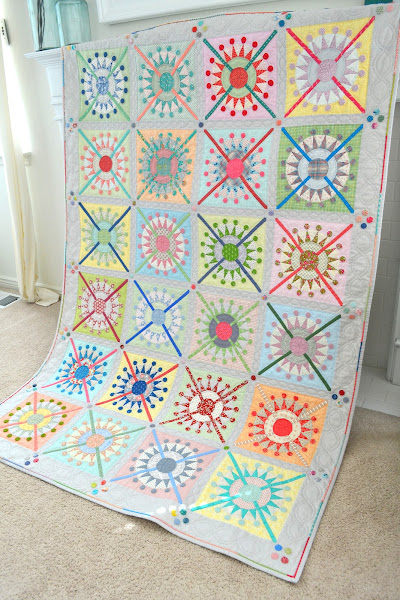Cutting the fabric might be a little tedious, but once you get the hang of it, this project goes quickly. It is not too late to whip this up to be part of your Christmas decorations.
* YOU NEED
4 different kinds of green fabrics
5 different kinds of red fabrics
White fabric
* HOW TO
1. Cut fabrics. The picture shows the parts you need to construct a block and the measurements are written in the picture. I only listed the measurements on one side because it is symmetrical.
2. Start from the bottom row. Lay green fabric down right side up and lay white 1 ½" x 1 ½" square on both ends right side down. Draw a diagonal line and sew on the line. Trim the excess and open the white fabric. Press with iron.
3. For the rest of the three rows, repeat the same process and add extra rectangle pieces to the sides.
5. Cut 24 pieces of 1 ¼" x 4" strips from white fabrics and 16 pieces of 1 ¼" x 1 ¼" squares from red and green fabrics. Piece the strips with the tree blocks as shown in the picture; make the rows first.
Then, make the "skinny rows" with the white strips and colored squares.
6. Piece the tree row and skinny row together. Press with iron.
7. From the white fabric, cut 2 pieces of 2" x 15 ½" for the side borders and cut 2 pieces of 2" x 17" for the top and the bottom borders. Sew them on, press with iron.
8. It is totally up to you on how you want to finish the quilt. I have been doing machine quilting on my last few quilts, so I decided to do hand quilting on this one. I used white, red and green thread. It was a lot of fun deciding which color to use where. One of my dream sewing machines is Sashiko from Babylock. I know; it is a one letter difference from my name. When I first glanced at the machine, I thought, "Wow! The machine has same name as me!" haha. Sashiko machine stitches are uniform and consistent, making it easier and faster to finish your quilting projects (there are many other ways to use this machine, too). You can achieve a hand quilted look with this machine! I LOVE doing hand quilting, but when I am older and it gets harder to hand quilt, there is still hope. :)
I hope you will have a wonderful holiday season. Thank you for visiting!





















































